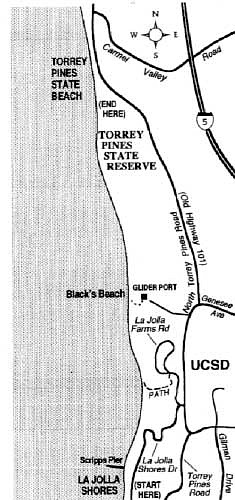 Facebook
Facebook
 X
X
 Instagram
Instagram
 TikTok
TikTok
 Youtube
Youtube
There are only a few places along the Southern California coastline where you can walk for miles in a single direction and hardly see any highway, railroad tracks, powerlines, houses, or other signs of civilization. The beaches below Torrey Pines State Reserve and the Torrey Pines golf course are one such place. Here, for a space of about three miles, sharp cliffs face the shoreline and cut off the sights and sounds of the world beyond.
If five miles one way isn't too much, begin your beach hike (or run) at La Jolla Shores Beach and travel all the way to Torrey Pines State Beach, past the end of the cliffs. Otherwise you can enjoy any smaller segment as you wish by entering or exiting the beach on the paved access path below La Jolla Farms Road, or by means of the trail descending from the glider port.
September, like August, along San Diego's coastline features the year's warmest sea and air temperatures. September, unlike August, is refreshingly uncrowded. Plan your outing during a low-tide period, when there's a wider, smoother, wet-sand surface to walk or run upon.
Walk north under Scripps Pier and on past the rocky tidepool area, which can be negotiated in sandals, or running shoes, or with bare feet if you aren't a tenderfoot. Once you're beyond the last of the cobbles and wave-rounded boulders, foot protection isn't normally needed.
Black's Beach ahead is San Diego's unofficial clothing-optional venue for sunning or bathing. Sadly, gender balance is hardly ever achieved in the pursuit of those activities.
At about four miles from La Jolla Shores Beach, you reach Flat Rock, where a protruding sandstone wall blocks easy passage. Follow the narrow path cut into the wall. From a low shelf on the far side, a trail slants upward, providing access into the scenically eroded landscape of Torrey Pines State Reserve.
In the fifth and last mile, the narrow beach is squeezed between sculpted sedimentary cliffs on one side and crashing surf on the other. These are the tallest bluffs in western San Diego County. A close look at the cliff face reveals a slice of geologic history: the greenish siltstone on the bottom, called the Del Mar Formation, is older than the buff-colored Torrey Sandstone above it. Higher still is a thin cap of reddish sandstone, not easily seen from the beach, called the Linda Vista Formation.
In the end, the beach widens and you arrive at Torrey Pines State Reserve's entrance and parking lot along North Torrey Pines Road.


There are only a few places along the Southern California coastline where you can walk for miles in a single direction and hardly see any highway, railroad tracks, powerlines, houses, or other signs of civilization. The beaches below Torrey Pines State Reserve and the Torrey Pines golf course are one such place. Here, for a space of about three miles, sharp cliffs face the shoreline and cut off the sights and sounds of the world beyond.
If five miles one way isn't too much, begin your beach hike (or run) at La Jolla Shores Beach and travel all the way to Torrey Pines State Beach, past the end of the cliffs. Otherwise you can enjoy any smaller segment as you wish by entering or exiting the beach on the paved access path below La Jolla Farms Road, or by means of the trail descending from the glider port.
September, like August, along San Diego's coastline features the year's warmest sea and air temperatures. September, unlike August, is refreshingly uncrowded. Plan your outing during a low-tide period, when there's a wider, smoother, wet-sand surface to walk or run upon.
Walk north under Scripps Pier and on past the rocky tidepool area, which can be negotiated in sandals, or running shoes, or with bare feet if you aren't a tenderfoot. Once you're beyond the last of the cobbles and wave-rounded boulders, foot protection isn't normally needed.
Black's Beach ahead is San Diego's unofficial clothing-optional venue for sunning or bathing. Sadly, gender balance is hardly ever achieved in the pursuit of those activities.
At about four miles from La Jolla Shores Beach, you reach Flat Rock, where a protruding sandstone wall blocks easy passage. Follow the narrow path cut into the wall. From a low shelf on the far side, a trail slants upward, providing access into the scenically eroded landscape of Torrey Pines State Reserve.
In the fifth and last mile, the narrow beach is squeezed between sculpted sedimentary cliffs on one side and crashing surf on the other. These are the tallest bluffs in western San Diego County. A close look at the cliff face reveals a slice of geologic history: the greenish siltstone on the bottom, called the Del Mar Formation, is older than the buff-colored Torrey Sandstone above it. Higher still is a thin cap of reddish sandstone, not easily seen from the beach, called the Linda Vista Formation.
In the end, the beach widens and you arrive at Torrey Pines State Reserve's entrance and parking lot along North Torrey Pines Road.
